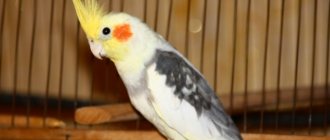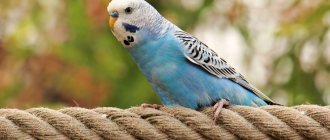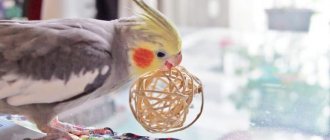Features and abilities of Corella parrots
The attractive appearance of the Australian bird contributed to the fact that the parrot received a second name - nymph. But beauty is far from the only advantage.
The owners include the following as the advantages of the species:
- Fast adaptation. The parrot quickly adapts to new living conditions and begins to behave at ease and freely.
- Ability to learn. With regular training, the cockatiel dances and sings, learns to reproduce the simplest words, and imitate all kinds of sounds.
- High life expectancy. In the wild, reaching 10 years of age is already a good indicator for this bird. At home, life expectancy almost doubles - some individuals live up to 25 years.
Species features:
- weight about one hundred grams;
- wingspan within 18 cm;
- body length (with tail) – 30 cm (+- 3 cm);
- The color of the body is gray, the head is yellow with bright orange cheeks, white inserts are noticeable on the wings. Males are slightly brighter colored than females.
The color described above is observed in birds in nature. In reality, there are many mutations specifically bred by humans to give a pet a decorative appearance.
Why does the cockatiel sing and dance?
Corella, like most other parrot species, is prone to imitation. Initially, singing is a way to communicate with others, including the owner. In nature, birds sing magnificently, but in an apartment with birds you need to work hard to hear the inimitable sounds.
At first, the parrot may make incoherent, high-pitched sounds, whistling or chirping. Under good conditions of detention, positive and regular communication with the owner, the range of vocal capabilities will invariably expand.
A dancing bird is not such a common occurrence, but your feathered friend can easily learn rhythmic movements if you constantly turn on catchy melodies and dance to them. A parrot is able to imitate not only sounds, but also human movements.
How the Corella parrot sings
Parrots of this species have a powerful voice. The sounds that can be heard from them are varied. Chicks sing songs from the age of two months, but adults reach the peak of their “career” at about two years. In general, the period when the cockatiel begins to sing is individual.
According to statistics, males most often sing and imitate human speech. But the females cannot be discounted; among them there are also very artistic individuals.
Whatever the sex of the pet, those who want to instill singing skills in their parrot should acquire a chick, not an adult. A bird with established habits is almost impossible to re-educate and teach anything.
Male cockatiel singing
Males of this species are indeed more vocal; the range of sounds available to them is extremely wide. Teaching a boy to imitate is much easier. Their musical abilities appear much earlier than in females and develop faster.
People who love silence are better off choosing a female parrot. Sometimes a male cockatiel sings and chatters incessantly, which not everyone will like. The male becomes especially “talkative” during the mating season. If we talk about the time of day, the male’s cry is heard most often in the morning.
How a female cockatiel sings
Females are more restrained in their emotions: their singing is a set of monotonous, not very expressive sounds. The “vocals” of females are uncomplicated and simple; even the most notorious singers give concerts much less often than males. The singing of a female cockatiel during the mating season is also not particularly passionate.
If you want to achieve great success in music, dancing and speaking skills from your feathered pet, it is better to buy a male. There is an opinion that female cockatiels are generally unteachable, but this is not true. It’s just that learning is more difficult for them, which means they will have to spend more effort to hear how the parrot imitates sounds and music.
Intellectual abilities
The intelligence of kakariki is inferior to many other birds, but the parrot is considered to be talking or simply capable of speaking. This species is very active and inquisitive. He has a good memory and is able to remember a large number of objects and family members.
How do kakariki sing?
To understand how things are and what sound the New Zealand Newborn produces in captivity, you can watch numerous videos on the Internet. This will make it easier for the owner to decide whether this particular sound is suitable for him and whether it will be pleasant to him if it is repeated regularly.
It should be noted that these pets love to sing, or rather, sing in the morning. They rejoice at the beginning of a new day with special activity. And in such cases, their singing resembles chirping, chirping, as well as whistling and characteristic clicks.
According to statistical data, the sound of a bird's voice is usually pleasant to the human ear.
Another advantage of the kakarik is his good memory, which allows him not only to independently perform arbitrary chants, but also to reproduce melodies he has ever heard and liked. This can be taught to the parrot separately if desired.
Does he speak or not?
Often there are complaints from owners that the kakarik does not speak. There may be several reasons for this.
But the main one is confusion with gender, because male parrots talk, but not female ones. Females scream exclusively during the breeding season before mating, and are silent the rest of the time.
How to teach a cockatiel to sing and dance
Any bird will sing and behave relaxed in the house where it is cozy and comfortable. Therefore, it is not enough just to regularly spend time near the cage with your pet, indulging in pleasant conversations; proper care is also necessary.
How to care for a parrot so that it learns to sing
This bird is a capricious pet that requires increased attention. Especially when it comes to parrots. Cockatiels singing in the wild is a common occurrence. And in order for this to happen in an environment alien to the bird, the following must be ensured:
- Good lighting. The sun's rays have a beneficial effect on any living organism. The parrot's cage should not be in a dark corner.
- Cleaning the “room”. The cage where the birds live needs to be cleaned regularly, ridding it of debris and waste.
- Air temperature. Guests from hot countries are sensitive to the cold; a freezing bird has no time for songs. The minimum required temperature that should be in the room is +20°C.
- Humidity. The room should not have either too dry or too humid air.
- Drafts. It is necessary to exclude the situation with drafts: cockatiels, when overcooled, lose their voice.
How to teach a kakarika parrot to talk?
After purchasing a parrot, many are surprised by its increased activity. He is very active and is always looking for new entertainment. For this reason, right from the first day a bird appears in the house, you should not immediately resort to trying to teach it to talk.
After a few weeks, you can begin to realize your goal.
To do this, it is necessary to organize classes. Another important point is the mental maturity of the ward, which should be more than 3 months, when he will be more receptive to this kind of training.
Songs and music for cockatiels
Songs for cockatiels are selected individually. Birds react differently to unfamiliar sounds. Some works arouse keen interest in them, while others can even frighten them.
Studies have shown that parrots do not perceive modern music in the style of techno and electro. Classical compositions, especially with the piano, have a calming effect on them, but do not make them want to dance. We need something perky and rhythmic. An artistic whistle is a good choice for a cockatiel.
In general, you need to monitor your pet’s behavior: the parrot will immediately let you know which songs he likes and which ones he dislikes.
Speaks with an accent
If, when thinking about buying a parrot, you put the ability to reproduce human speech in the foreground, then it is better to abandon the kakarika right away. These birds are hardly able to remember a dozen words, and they can only pronounce them with a terrible “accent.” It happens that the spoken word very vaguely resembles the original one, and it can hardly be recognized.
If the quality of speech is not so important for you and mutual communication with your pet is in the foreground, feel free to buy a male kakarika and start training. These parrots are very diligent and will bring you joy by showing sincere diligence in their studies.
But get ready to become a real teacher and an all-forgiving educator yourself. For those who do not know, let us explain that a jumping parrot in no way connects the words it has learned with any thoughts in its own head. He simply repeats the memorized word. So don't expect coherent chatter from him.
Cockatiel Nymph Sound Dictionary
A bird living at home, even if it cannot speak, has a wide range of various vocal techniques. Listening to the sounds of Corella parrots, it is easy to understand what mood the pet is in and what worries him.
Here's what a short dictionary of the cockatiel's “language” looks like:
- Corella chirps loudly and intensely - the pet is scared and sounds an alarm. The cause may be a sharp sound or unexpected movement.
- The non-stop, long chirping of a parrot indicates that the bird is bored, thirsty for communication, or ready to mate.
- The pet usually makes sounds similar to hissing in the first days of being in a new place. This is a sign of anxiety, fear.
- The grinding of its beak indicates that the pet is getting ready to sleep.
- The parrot screams and squeals when there is too much noise around its home. Also, the reason for this behavior may be the bird’s reluctance to remain alone, unfavorable environmental factors, or lack of sleep. The cry of a cockatiel in the morning is a natural phenomenon: the bird has woken up and notifies household members about it.
- Cockatiel parrot songs and whistles mean that the pet is in a good mood.
Corella parrots are sociable, friendly, affectionate and smart. Listening to them sing and chirp is a real pleasure. These pets are able to fill any room with positive energy and turn every day into a holiday with their joyful chirping.
If you regularly play this video for your pet cockatiel, after a short time he will begin to play a very melodic and beautiful melody:
Training rules
The kakarik parrot is a highly active bird that is constantly on the move. He is curious and brave, but moving to a new home requires adaptation. So don't bother him for at least a few days. Let the bird get used to it and stop being afraid of your appearance near the cage. You can read more about taming in the article “Keeping Amazonian parrots using the example of the Venezuelan Amazon.”
To teach a kakarika to speak, remember some rules:
- the parrot must be tamed,
- during classes, all extraneous sound sources are turned off,
- conduct classes at least twice a day for 20 minutes,
- For any attempt to repeat the sound, reward your pet with a treat.
At first, lessons should be conducted in a cage, then the parrot's attention will be focused on you and what you say.











